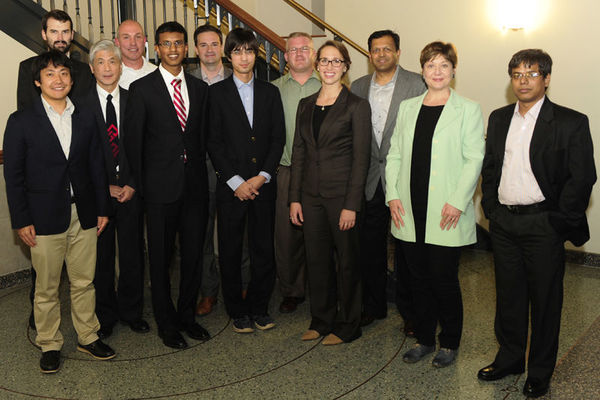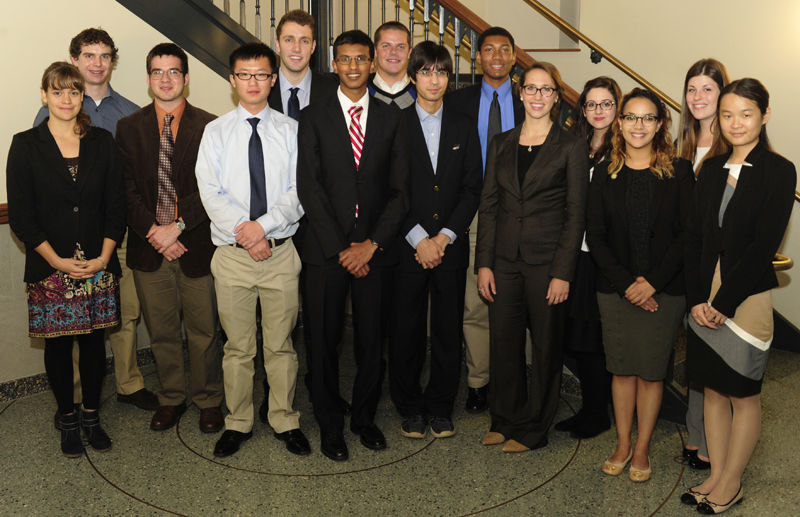For the second straight year, a student from Northwestern University has won first place in the University of Notre Dame’s NDConnect national undergraduate research poster competition.

Left to right: Yoshiyuki Kondo (Toshiba), Todd Major (MicroLink Devices), Yuji Nakanishi (Murata Electronics), Chris Vander Tuuk (Olympus), Ethiyal Raj Wilson (3rd place - University of Nebraska), Dane Wheeler (HRL Laboratories), David Heydari (1st place - Northwestern University), Erik Probstfield (International Rectifier), Monica Ohnsorg (2nd place - Hope College), Ram Chelakara (Raytheon), Roxana Nicolaescu (Serim Research), and Arup Polley (Texas Instruments).
David Heydari, a senior electrical engineering major at Northwestern, won top honors and $3,000 for his work on “High brightness angled cavity quantum cacade lasers” – research he published earlier this year in Applied Physics Letters, along with his adviser, Prof. Manijeh Razeghi.
NDConnect draws students from around the country, who are selected from a field of applicants to present their research in nanoscience and nanoengineering to a panel of industry judges. The event was held at Notre Dame on October 23.
"David did an exceptional piece of work for this project," said Erik Probstfield, International Rectifier. "He demonstrated considerable insight to his particular field of study. His initiative, determination to drive his research forward, and passion for his research are all critical attributes of exceptional research professionals. Lastly, the actual achievements (constructing the most powerful quantum cascade laser to date) was quite remarkable for an undergraduate-level project. All of these factors combined to make David the clear choice for the judges as the best project of this year’s competition. We look forward to seeing David’s achievements in the years to come as he continues to grow in his research career."
Fourteen finalists competed in the 2015 event, where each gave a four-minute presentation on their research and then answered judges’ questions at an afternoon poster session.
At the awards dinner, Dr. Ram Chelakara, Raytheon, complimented all the finalists on their research and participation in the event. “This was my third year as judge at NDConnect and I continue to be amazed at the level of work you are doing as undergraduates. It is very, very impressive."
Second place and $2,000 was awarded to Monica Ohnsorg, a senior studying chemistry at Hope College. Monica’s research focused on “Understanding fundamental metal-organic thin film growth to further integration into applied devices.” Monica’s adviser is Prof. Mary Anderson.
"Not only did Monica obtain impressive scientific understanding and results, but she did so while demonstrating superb enthusiasm and initiative," said Dr. Dane Wheeler, HRL Laboratories.
Ethiyal Raj Wilson, a junior studying electrical engineering at the University of Nebraska–Lincoln, won third place and $1,000 for his work on “Boron carbide for neutron voltaics in deep space missions and other applications.” Ethi is advised by Prof. Peter Dowben.
"Ethi was very eloquent and precise at explaining the significance and impact of his research work on the big picture applications," said Dr. Chelakara. "It also helped that he had excellent results."
NDConnect 2015 was sponsored by Altera, Coherent, HRL Laboratories, International Rectifier, MicroLink Devices, Murata Electronics, Ocean Optics, Olympus, Raytheon, Serim Research, Texas Instruments, Toshiba, and ThorLabs. Representatives from nine of these companies served as judges for the event.
Congratulations to all NDConnect 2015 finalists!

Photos: Wes Evard, Notre Dame
- Elizabeth Dresselhaus, a junior studying physics at the University of Pennsylvania. The title of her project is “Trap state measurement in quantum dot photovoltaic cells.” Prof. Cherie R. Kagan is Elizabeth’s adviser.
- Jacob Wisser, who is a senior majoring in physics at Pennsylvania State University. His project, advised by Prof. Nitin Samarth, is “Electric and thermoelectric transport in Bi2Te3/Sb2Te3 short-period superlattices.”
- Thomas Werkmeister, a junior in engineering physics at the University of Pittsburgh. Thomas is advised by Prof. Paul Leu, and his project is “Fabrication of molybdenum disulfide (MoS2) atomic layers via chemical vapor deposition.”
- Yi Zhang, a senior studying materials science and engineering at the University of Wisconsin. His project is “Direct and reliable CVD/PVD synthesis of WSe2, and heterostructure nanoplates." Yi’s advisor is Prof. Song Jin.
- Aleksander Piasecki, a junior in chemical engineering at Pennsylvania State University. Alek’s project is “The effect of ionic solution composition and concentration on the stability of titanium dioxide nanoparticles.” He is advised by Prof. Mark Wiesner of Duke University.
- Ethiyal Raj Wilson, a junior electrical engineering major at the University of Nebraska. His project is “Boron carbide for neutron voltaics in deep space missions and other applications.” His adviser is Prof. Peter Dowben.
- Mark Hartwig, a chemistry major in his senior year at the University of Michigan. His project, advised by Prof. Kerri Pratt, is “The effect of changing sea ice features on arctic snow composition.”
- David Heydari, who is a senior studying electrical engineering at Northwestern University. David’s project is “High-power quantum cascade lasers with angled cavities.” He is advised by Prof. Manijeh Razeghi.
- Trey Lee, a senior in materials science at the University of Virginia. His project is “Characterization and optimization of 2D transitional metal dichalcogenides synthesized by atmospheric pressure chemical vapor deposition,” and his adviser is Prof. Petra Reinke.
- Monica Ohnsorg, who is a senior studying chemistry at Hope College. Her project is “Understanding fundamental metal-organic thin film growth to further integration into applied devices." Prof. Mary Anderson his Monica’s adviser.
- Joana Sipe, a senior in chemical engineering at Arizona State University. Joana is advised by Prof. Paul Westerhoff and Prof. Pierre Herckes. The title of her project is “Synthesis and lifecycle analysis of layer-by-layer silver nanoparticle coated fabrics.”
- Sara Boukdad, who is a senior in environmental engineering at the University of Notre Dame. Sara’s project, advised by Prof. Peter C. Burns, is “Solubility of uranyl phosphates in nanocluster forming environments.”
- Emily Eikey, a senior at Allegheny College studying chemistry. Her project is “Determining the apparent equilibrium dissociation constant between DOIDA and Cu (II),” which she completed at Pennsylvania State University under the advisement of Prof. Paul Cremer.
- Jiechen Wang, a senior in materials science and engineering at the University of Illinois. Jiechen’s project is “Kirigami-inspired, 3D assembly of silicon nanomembranes by compressive buckling.” She is advised by Prof. John A. Rogers.
Winning Projects
First place - High brightness angled cavity quantum cacade lasers
David Heydari's project focused on creating powerful quantum cascade lasers with excellent beam quality using a simple processing method. Quantum cascade lasers are the only semiconductor sources that can emit at room temperature in the mid-IR regime, which makes them extremely useful for applications such as communications and stand-off spectroscopy.
Second place - Understanding fundamental metal-organic thin film growth to further integration into applied devices
Monica Ohnsorg investigated the fundamental layer-by-layer deposition of two metal-organic coordinated thin film systems (multilayers and surface anchored metal-organic frameworks), determining the growth mechanism and the effect of temperature on surface morphology to better integrate the thin-film systems into sensing and gas storage device architectures.
Third place - Boron carbide for neutron voltaics in deep space missions and other applications
Boron carbide, says Ethi Wilson, has proven itself as an excellent material for neutron voltaics. These unique voltaics absorb high-energy neutrons to produce electricity. However, linking groups can improve boron carbide’s performance, so more electricity can be produced more consistently. The addition of pyridine improves boron carbide as a neutron voltaic significantly, and is a recent discovery. Studies are needed to explain the detail origin of the improved charge collection and whether there might be other linking groups that perform even better. In other words, is there still an even better boron carbide out there?
11.12.15